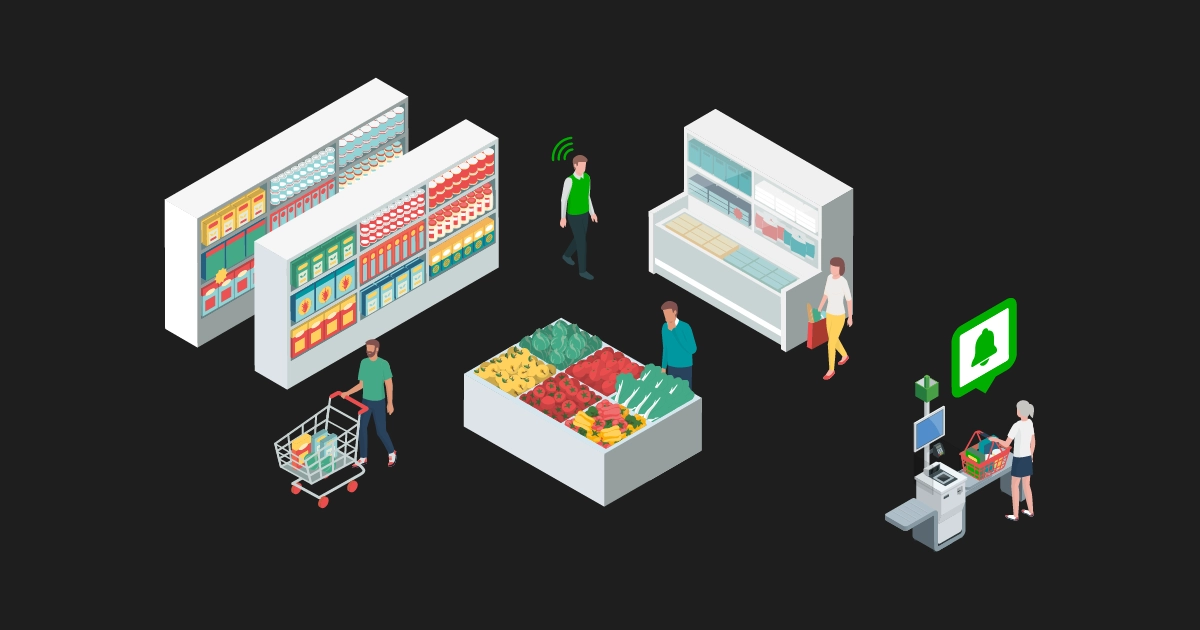
Retail is evolving faster than ever. What was once science fiction, such as smart shelves that know the instant a product is running low, automatic checkout options and AI systems that solve store issues in real-time, is already live in many stores. And excitingly, these smart retail solutions don’t just work in silos, but can connect, creating truly responsive and connected stores.
However, the excitement behind this shift toward intelligent retail operations isn’t just about impressive technology; it’s how that tech is being used to create more efficient operations, better customer experiences and sustainable business growth. But what exactly are smart retail solutions, and how are they reshaping the entire industry?
Let’s take a closer look.
What are smart retail solutions?
Smart retail solutions are systems that are designed to connect and, in effect, “talk” to other devices and solutions. More than just a single piece of tech, they bring together the Internet of Things (IoT), AI, data analytics and automation to create smarter ways of working.
What is smart retail technology?
Essentially, it’s another name for smart retail solutions. Unlike traditional siloed tech, smart retail technology unlocks real-time insights into not only system performance but also customer behaviors. For example, smart call points connected to a retail communications solution can notify staff when a customer needs help. That same solution can create detailed analytics, exposing trends and potential gaps in your sales floor coverage. This shift to connected data-rich systems is helping retailers move from reactive firefighting to proactive planning, allowing them to optimize their operations.
But not all of these systems are, or should be, self-contained. While some tasks can be done automatically, most stores are not fully automatic, and those that are are quickly exiting the market. That’s why the most exciting part about these solutions is real-time communication — the power to connect and communicate with in‑store staff. Because store associates play a powerful role in not only providing oversight, but also in ensuring that any productivity gained from these technologies actually translates into a smooth shopping journey.
How much do smart retail solutions cost?
Honestly, it depends on the vendor, whether it’s billed as CAPEX or OPEX and even the size of your order. It’s worth asking for quotes from a couple of comparable solutions to get a clear picture of your options. Just remember to ask up front if there are any extra charges for installation, integrations or, if you’re paying monthly, whether or not hardware replacements are included.
Seven essential smart retail technologies every store needs
As you may have guessed, the smart retail landscape is varied and growing rapidly. Valued at $57.30 billion in 2024, the global retail market is projected to reach $350.85 billion by 2032, thanks to the value and ROI retailers are seeing from the following key technologies:
IoT retail solutions
The current market leader, IoT-enabled devices form the backbone of smart retail. From connected sensors to environmental monitoring, IoT ensures data flows continuously between systems, giving retailers real-time visibility into everything from inventory to customer behavior.
Smart shelves
Equipped with weight sensors and digital displays, smart shelves are a specific type of IoT device that provides instant insights into stock levels, reducing stockouts and alerting staff to possible theft. Connected to other systems, they can even automatically trigger orders or adjust pricing in real time, ensuring customers enjoy a seamless experience.
AI-powered systems
Beyond the hype of gen AI, artificial intelligence encompasses machine learning, predictive analytics and agentic AI. Depending on the solution and its training, AI in retail can interpret customer behavior, optimize inventory planning and support store associates with product recommendations or procedural lookup. In essence, these solutions both interpret and act on data provided from other smart technologies, improving operations incrementally over time.
RFID technology
Radio Frequency Identification (RFID) has evolved beyond simple product tracking. Today, RFID provides real-time inventory visibility, accurate product location data and supports loss prevention. It also produces analytics that reveal product movement and performance, giving retailers actionable insights that can help them improve their bottom line.
Automated checkout systems
From self-service kiosks to fully cashier-less experiences, automated checkout reduces wait times and frees up associates to focus on higher-value tasks. These systems improve convenience, though they still require employee support for age verification and spot checks.
Mobile POS systems
Flexible enough to work in small retail spaces or anywhere on the sales floor, mobile point-of-sale (POS) solutions are associate-operated payment options that allow customers to finish their journey wherever and whenever they’re ready. By combining payments with access to full product catalogs and customer history, associates can provide faster, more personalized service, while reducing bottlenecks at stationary checkouts.
Do small retailers need smart retail technology?
To run a successful store today? No. To stay competitive and future-proof the business? Yes. However, it’s worth assessing what your actual store needs are and adopting that technology first. For example, payments. Make sure you make it easy for your customers to pay. That may mean keeping a manned checkout and simply adding in an automated one as a second option. Take on each piece of technology as and when it fits into your overall goals and plans.
Smart retail software: Five platforms that connect your store
To get the full value of IoT devices and smart solutions, they need to be talking to something. And that’s exactly where integrated retail software platforms step in. Some of the key platforms include:
- Unified commerce platforms, which seamlessly integrate online, mobile and in‑store channels so that customers can enjoy consistent customer experiences.
- Advanced inventory management tools that go beyond stock tracking to provide predictive analytics, automated reordering and intelligent distribution across multiple sites based on customer demand patterns.
- Customer relationship management (CRM) systems, which integrate data from all customer interactions to create comprehensive profiles, enabling retailers to offer personalized service and targeted marketing campaigns.
- Retail analytics and business intelligence (BI) tools, which are vital for transforming raw data from multiple sources into actionable insights about everything from customer behavior to business performance.
- Smart communication platforms that not only connect employees, but also deliver insights and alerts from other smart systems to relevant staff members in real time, enabling associates to immediately respond to what's happening in the store.
While many retailers already use a combination of these platforms, many are still stuck with siloed systems. Why? Because while, for example, their inventory management system may be connected to smart shelves or RFID tracking systems, everything is either handled automatically on a computer, making planning a breeze, but providing little support for dealing with immediate issues.
Luckily, with the right in‑store communication solution, retailers can connect these back office technologies to staff on the shop floor, creating the final link in a truly connected store.
How long does smart retail implementation take?
It varies wildly. Some solutions are plug-and-play and can be set up in a few hours or a day max. However, the more integrations you need, the longer it’s likely to take. Which is why it’s important to research your vendor well and have a solid implementation plan.
How to implement smart retail technology
Inspired to install some smart retail technology in your stores? First, remember that successful implementation hinges just as much on how you approach it as it does on the technology itself. It requires careful planning, which can be broken down into the following steps:
- Plan a phased deployment. Look to minimize disruption while allowing your team to learn the system before expanding to additional locations or adding on more sophisticated features.
- Decide how you'll measure the ROI. You need to know not only how to judge if the technology is successful but also if you can justify the investment. Trying to do so after the rollout makes it difficult to collect metrics and do a clear before/after comparison. By thinking the measurements through and having a clear plan, you'll also clearly set the expectations your tech provider will need to meet to continue your relationship.
- Draft a staff training and change management plan. Even the most user-friendly tech will require at least a structured introduction if you want your team to fully embrace it. Make sure you also include sessions where you can address concerns and highlight how the new technology actually improves your team's workload.
- Prepare for system integration challenges. Make sure you check with your new and current technology providers to ensure there aren't any extra steps needed to ensure a smooth integration. For example, you can ask if the technologies have ready-to-go integrations and open APIs, or require you to pay for bespoke integrations. Also, make sure the integration actually creates the workflow that you need for your operations. Failing to take this crucial step may leave you with a poor integration that doesn't bring you the return on investment you were hoping for.
- Select a compatible smart communications solution. Once your IoT device or other solution is running smoothly, it's worth considering adding communication on top to tie everything together. When looking for a communications vendor, consider the following criteria:
- Can they integrate with your existing and planned in‑store technology?
- Do they offer a hands-free, voice-powered option for store associates?
- Are they constantly innovating, giving their customers access to new features, or is it a static product?
- Can it offer or connect telephony features, allowing you to connect your entire estate?
By following these steps, you give yourself the best chance of a successful rollout. But even with careful planning, every new technology comes with trade-offs. That’s why it’s important to weigh both the benefits and the challenges before making the leap.
Smart retail ROI: benefits, costs and common challenges
When a smart store installation goes well, stores should be able to immediately see movement in some of their key metrics. While it varies by solution, common benefits can include:
- Enhanced data insights
- Greater operational efficiency
- Increased sales
- Improved customer experience
But sometimes even the right technology with the best rollout can come with challenges. And it’s worth considering them in advance to determine if the potential gains are worth the strife. For example, a solution can sometimes come with:
- High implementation costs
- Costly or complex integrations
- Data and cybersecurity concerns
- Staff resistance or slow adoption
Understanding these benefits and challenges is key to making smart investment decisions today, but it’s just as important to look ahead. While we can’t predict the future, choosing technology that not only delivers a quick return on investment but also fits into your five-year plan will help set you up for success.
Future trends and innovations
One thing we can predict, however, is that smart retail solutions aren’t going away anytime soon, since they are key to accelerating the development of smooth store operations and seamless shopping journeys across platforms. But some particular upcoming technologies to look out for include:
- Augmented reality. Especially solutions that allow customers to digitally preview products before they buy them, as it boosts confidence and reduces returns.
- Voice-first technology. Whether staff or consumer-focused, communication solutions that allow users to interact with systems through natural language will become more and more widespread as they make technology more intuitive and accessible.
- Sustainable technology. Solutions that support retailers to cut energy use and waste will be vital not only to reduce costs but also to meet the growing consumer demand for responsible practices.
- Edge computing. With so many devices needing high-speed connectivity, the rise of edge computing is inevitable, as it can deliver real-time processing at the store level, improving response times and reliability by not relying fully on the cloud.
- Next-generation communication systems. Smart in‑store communication solutions will be the glue that binds all these innovations together so staff, systems and AI can coordinate seamlessly in real time.
These advances show just how fast retail is evolving, but one thing we highlighted in our recent post on 2026 retail trends is that no matter how sophisticated the technology, success depends on how well systems and staff are connected.
Conclusion: Building truly connected stores
Smart retail solutions are no longer a “nice-to-have” — they’re essential if you want to stay competitive. But choosing the right technology is only part of the equation. The real value comes from connecting those systems with your people, ensuring valuable insights turn into action.
That’s where x‑hoppers comes in. By uniting associates, smart devices, telephony and AI into a single retail communications platform, x‑hoppers has the power to create truly connected stores. Stores where, for example:
- IoT sensors notify staff the instant stock runs low
- AI assistants alert associates to customer needs so they can respond on the spot
- Automated systems log tickets and contact the right people the moment support is needed
And thanks to our in‑house R&D department and open APIs, the sky’s the limit to what you can integrate, allowing you to create workflows and connected systems that are tailored to your business. Because the smart retail revolution isn’t about changing your stores to fit the latest trends, it’s about enabling your people and tech stack to work seamlessly together.
Ready to connect your stores? Speak to our team to discover how today.



